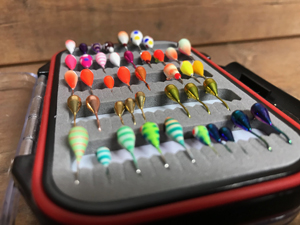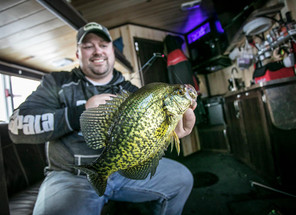Posted by Chris Larsen on 30th Oct 2019
How To Choose Lure Colors For Ice Fishing
We’re talking colors in today’s post. Specifically, how to choose lure colors for ice fishing. Chances are if you ask five different ice anglers their favorite color, you’ll get at least three or four different answers. People are always asking “what is the hot color?” The truth is, when the bite is hot it probably doesn’t matter what you drop down the hole. But when things are tough the smallest details can make a difference.
There are a lot of factors that go into finding the correct color jig for ice fishing. The most common factor is water clarity. Scott Wilhelm, fishing manager at the Eau Claire, Wisconsin Scheels starts his day dialed in on clarity and the weather conditions.
“I tie up combos based on the weather and water quality. I use dark colors on cloudy days. Bright chartreuse and vibrant stuff on sunny days. If it’s a really clean, clear lake I’m more apt to use some natural colors like motor oil and pumpkin”
In clear water, fish can see better. They use sight as a primary method for filling their bellies so having a natural presentation is key. In dark or stained water, visibility is decreased. Contrast and flash become more important. Metallic jigs like gold and silver are a good place to start. Jon Thelen from Lindy Fishing Tackle says making sure fish can see your lure can make a big difference when it comes to catching more fish while ice fishing.
“I think it’s so important in ice fishing that they see it. What you have to remember is, fish are meandering around in the winter. They’re not actively running around and feeding except for small short windows. I’m a firm believer that you have to grab their attention more in the winter than you do in the summer. In the summer, fish, specifically, walleyes, are feeding all day long. There’s always a pod somewhere feeding but in the winter there’s always a period of quiet.”
Twilight hours are often considered the best time to fish through the ice. As the sun fades into the horizon, light conditions change underwater. Bright colors begin to fade while blue and green actually become more visible. Something with some flash like a spoon can be deadly as light diminishes. The goal is to get the attention of fish.
Paul Ghizoni from Minnesota Made Outdoors is a firm believer that size matters. “We’ve all seen how fish see color in the spectrum. Black looks like blue looks like purple. But as it gets deeper it changes. I don’t buy too much into color. The pattern probably means more to me than color. But I would say size and presentation over anything else. If I know there 13”, 14”, or 15” crappies in a lake, oftentimes I’m going to start big and downsize from there. There have certainly been days when a pressure system comes in where you have more confidence in a 3mm jig and one tiny little larvae sticking out the back, and there are some days that works. But personally, I like to start big and downsize from there.”
As darkness sets in, a lot of anglers like to go to glow jigs. A glowing jig stands out in dark water, even during daylight hours. Glowing jigs mimic the flash of forage when it moves through the water column. Todd Heitkamp from Dakota Angler says it’s important to maintain the glow of your jig when fishing with them.
“I definitely use glow jigs in water that’s stained, especially in Northern Minnesota’s Lake of the Woods. I use an LED flashlight to give it a high-intensity charge and cause that jig to glow as much as I can. The key to remember when you’re using glow jigs is to continue to recharge them as much as you can because of that stained water.”
It’s important to note that while the water clarity of a lake might not change much during the ice season, as the season progresses and there is more snowpack on the ice, conditions get darker throughout the water column. So a natural color could be the ticket earlier in the season, but going to something brighter will be necessary as more snow prevents light from penetrating. At that point, adding some flash or using a glowing lure to your presentation can make a big difference.
Another thing to consider is depth. Current can be a factor depending on where you’re fishing, but visibility tends to be better in ten feet of water compared to 30 feet of water. The same rules apply. Use natural colors where visibility is higher.

We’ve talked a lot about visibility and light. But another way to put more fish in the bucket is to mimic the food source. If you know walleyes are feeding on small perch, yellow, green, and orange could be great colors. If crayfish are the main food source, use a darker color like red or black.
So what’s the best color for ice fishing? The answer is, it depends. Sunlight, water clarity, snowpack, and forage base can all be factors. I recently visited with Josh Clawson. Josh is one of the founders of Fish Addictions TV and an accomplished tournament angler. Josh likes to have several rods rigged up and ready to go with different colors and presentations. He experiments until the fish tell him what they want.
“When I’m hole hopping, I’ve got my flasher and I’ve got six rods. People ask, “why do you run so many rods?” I want to have options. It goes back to the rule of threes. If you get rejected three times, first change your jigging cadence, how you’re jigging your lure. If you get rejected on three different jigging cadences, switch your lure… generally color first. I’ll go dark, bright, and fluorescent. There are many different color combinations out there. A black or motor oil, then a white or even your silvers and golds, and then go to your bubble gum or chartreuse.”
Having a wide range of options can help you be more successful on the ice. If you get tired of tying new jigs on your line, carry a nice selection of plastics or live bait to change up your colors without doing a lot of work. On a trip I took a few years ago, red spikes outfished white spikes by a margin of three to one. For some reason, the crappies really liked red while a white spike on the same jig dropped down the same hole produced much different results.
Part of the fun of fishing is figuring out what the fish want. Catching fish when the bite is hot is enjoyable. catching fish when everyone else is going home empty-handed is rewarding.
Need a great rod holder for your next ice fishing adventure? Check out our store by clicking here.

